Keyboard Concept Designs
for Early Learning and Special Needs
Keyboards designed for adults are impenetrable to small children, while those intended for Early Learning tend to be cheap, breakable consumer toys, with flat membrane keys that are difficult to operate. In fact the quality of design and construction demanded for effective Early Learning use are greater than those for adults; cheap toys are absolutely the wrong way to go. When properly designed and presented, young children can focus on the function and understanding; such keyboards offer many opportunities for structured learning.
The series of concept designs presented here all feature robust keyboards tailored to Early Learning needs. They have been evolved at various times and with varying degrees of sophistication. What they all offer is a specific solution to a specific set of learning goals and associated activities.
In particular, all are aimed at the next steps beyond our robust Joypad. They offer the same familiar functionality through arrow keys, before moving on to letters, numbers and colours. Some offer far more.
See also our switch input devices.
Rainbow Mk 2
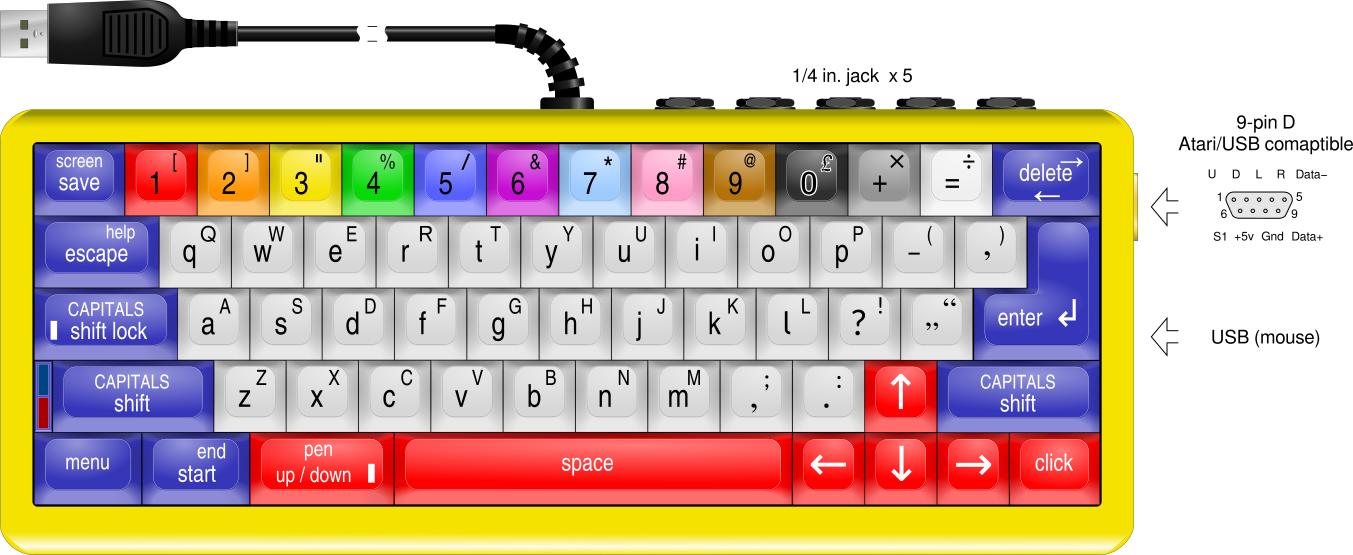
Our most recent and mature design as of 2020, the second iteration of the rainbow concept is a full-size keyboard with conventional - and individually replaceable - sculpted mechanical keys. Colour codes group broad key functions together in an attractive and intuitive way. Incorporating the best of the previous studies, it adds turtle control and graded Logo instruction programming, as well as a general refresh to the technology environment.
It covers multiple activities from the earliest joypad input to intermediate-level typing, graphics and even basic computer literacy. Its aim is to initially introduce computer interaction via dedicated keys, graduating through indirect key functions to graphical widget and menu item selection, and on to programming and data handling concepts.
Key features are listed below.
Physical:
- Robust physical cable makes visible and tangible connection to PC/monitor.
- Inputs for special switches, conventional mice and similar peripherals (e.g. a Joypad) for integrated use with both keyboard-compatible and mouse-controlled software; USB, 9-pin D, 5 x 1/4" jack.
- All connectors are pull-out for safety and equipment protection. (It always amazes me how so many designers add robust connector locks everywhere and then wonder why the wrong bits get yanked apart).
- Doubles as an input adapter for Special Needs switch input devices.
- Packs away, with cable, in a low-profile A4 form factor for easy storage.
Earliest interaction:
- Joypad input, beginning at 1 year or less with the big button at the front.
- Joypad function compatible via arrow keys and space bar, leading directly on from use of the Joypad itself.
Basic learning:
- 12 colour keys for learning, drawing and painting. These are just the commonest Early Learning colours and comprise the basic colour wheel, cyan and magenta (in the guise of sky and pink), brown, and a simple greyscale.
- Numbers.
- Lower-case letters for learning and using the alphabet in the UK. The US version retains the connventional upper case.
- Qwerty layout for forward compatibility; no need to relearn later on.
- Turtle functions for direct control and (later on) programming. Indicator LED for pen down.
Advanced learning and control:
- Basic punctuation and counting for initial typing and numeracy, without need to use the shift key too soon.
- Caps/Shift key accesses wider range of characters for more advanced typing and arithmetic. Indicator LED for caps/shift lock.
- Logo programming language basic command characters for programming in a subset of Logo.
- Menu key allows for pop-up file management, printing, administration, etc. without disturbing the full-screen learning mode.
- Comprehensive save, undo and help function keys.
Many of these features appeared in the earlier designs.
Implementations
The design is capable of being implemented as either a keyboard peripheral connecting to any common PC, or as a standalone micro needing only a TV or monitor to give full netbook or chromebook functionality. Each mode is aimed at a different user requirement:
- For a mature school network with installed PCs, the keyboard peripheral avoids any problems with transition, maintenance and administration.
- The standalone micro can be more suited to nursery, transition and home use where a typical PC might suffer rough handling and/or provide a safety hazard. It is also more flexible and portable; a keyboard-only mode still allows connection to a PC. No extra connectors are envisaged; an integral battery provides a full day's usage and is recharged through the USB cable in the usual way, while additional connectivity is provided via WiFi and Bluetooth. However security issues with Internet connectivity pose questions over the advisability of wide connectivity. An integrated A4 footprint netbook with folding screen is a possible solution, however robust construction poses a problem.
Rainbow Mk 1
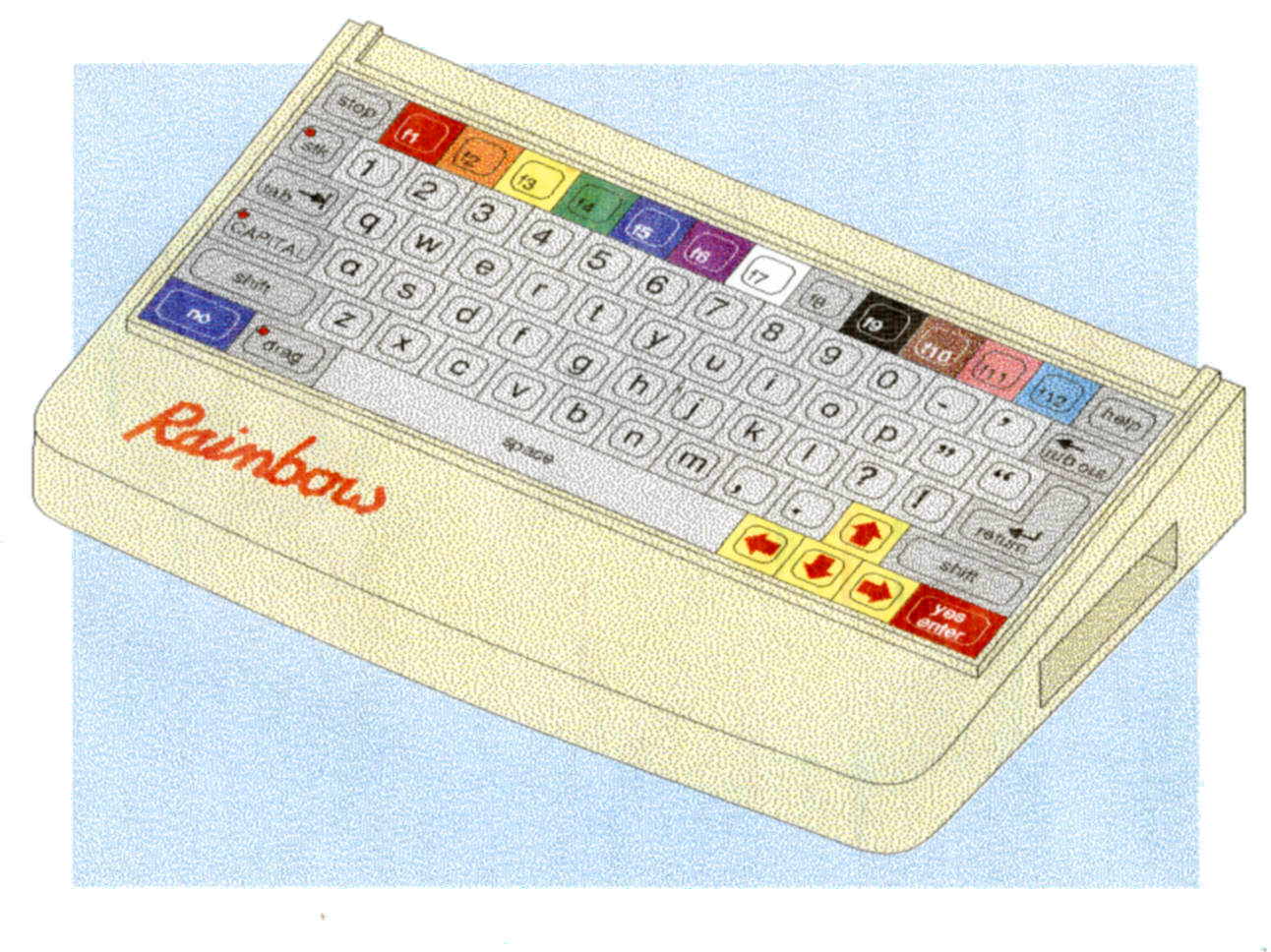
The Rainbow Mk 1 was a 1990s study for a standalone 8-bit micro with a full range of learning functions. Although Joypad compatible, it was more oriented towards the old text-based operating systems such as BASIC.
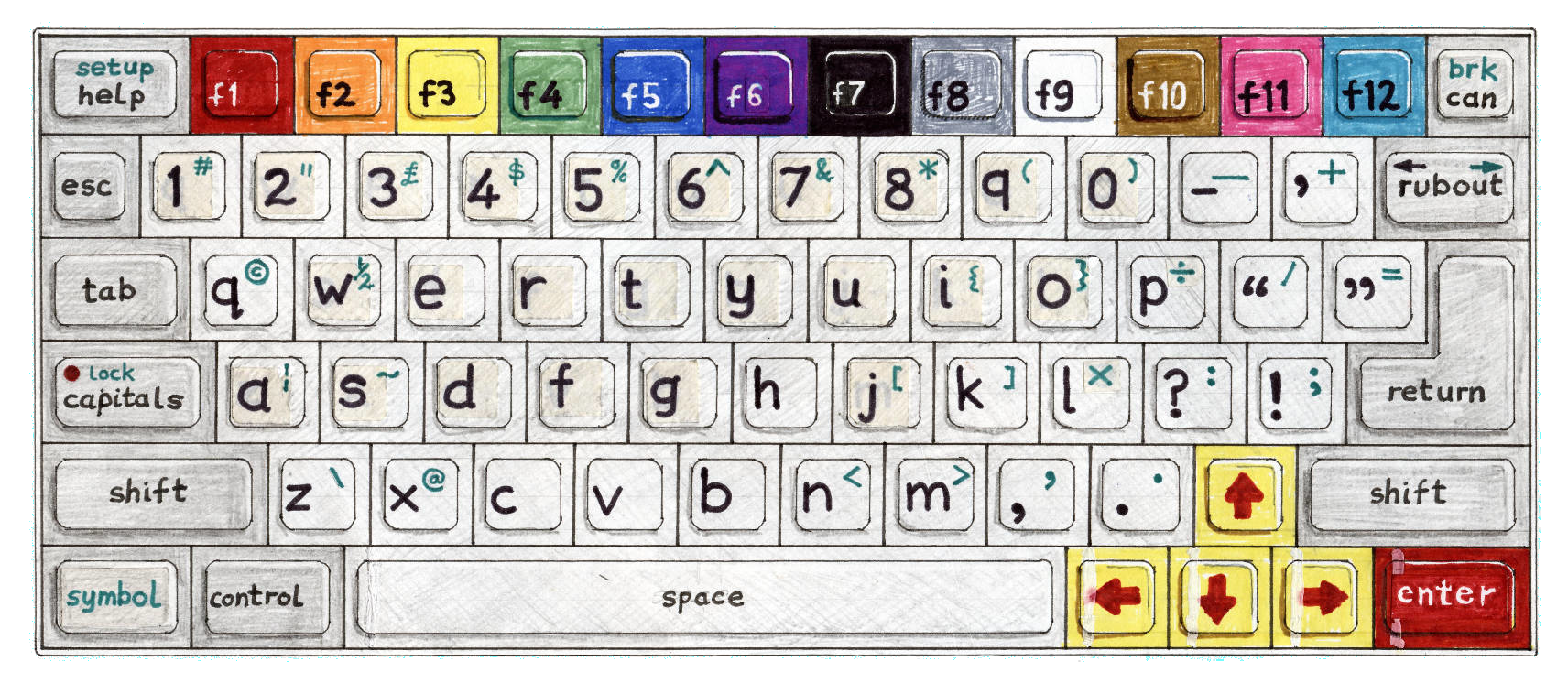
It was aimed at a narrower age range, lacking the turtle, programming and fuller puctuation of the Mk 2. On the other hand its colour keys doubled as function keys with a holder above the keyboard for overlays.
Its colour palette was 8-bit, based on RGB with three bits each (eight levels) for red and green, and 2 bits (4 levels) for blue. This allowed better rendering of browns and other basic colour shades than the very limited palettes of early 8-bit micros, without the expense of complicated circuitry.
Prism
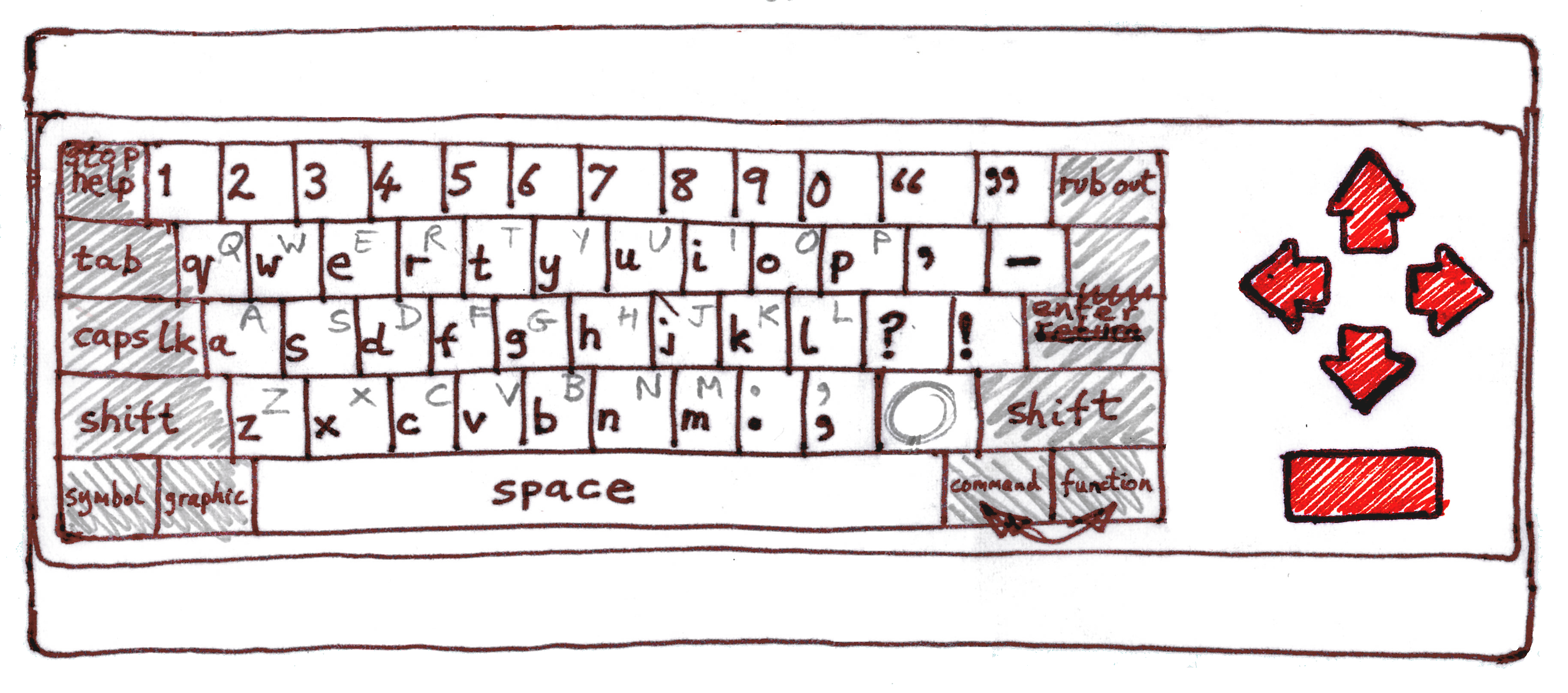
The Prism was among our 1980s designs. Its later iterations were aimed more directly at migration from the Joypad, having a replica joypad alongside the main keyboard.
Featuring the 7-bit colour palette of the SAM Coupé, it was envisaged as a development of the SAM with TV-quality digital audio output.
The earliest variant took as its starting point the interactive toys then appearing. It kept their alphabetical keyboard layout and small button-style keys, which proved unpopular with teachers. It did include a "compass rose" joypad which predated the Early Learning arrow buttons and later became popular on games consoles. It also featured a small status display screen above the joypad, offering facilities similar to those of the Rainbow Mk 2's Menu key.
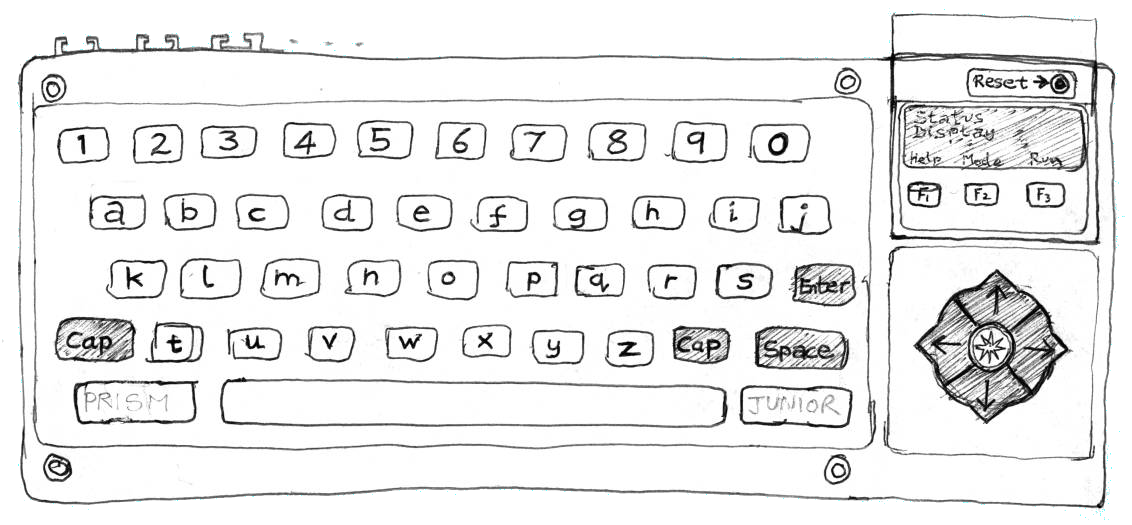
Holdfast Technologies, Park View, Queenhill, Upton-on-Severn, Worcs, WR8 0RE, United Kingdom.
Tel: +44 (0) 1684 594728 Email: holdfast@steelpillow.com